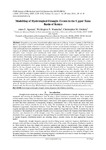| dc.description.abstract | Drought is a recurring hazard which affects many parts of Kenya. In most countries in Sub-Saharan Africa, agriculture which is predominantly rain-fed is the main stay of the economies is highly prone to the impacts of drought which, whenever it occurs, leads to serious socioeconomic challenges at various levels. The study of drought duration, magnitude and severity have relevance in many areas such as waste load allocations, issuance of pollution discharge permits, location of treatment plants and sanitary landfills, determination of allowable water transfers and withdrawals both within, between and outside the affected areas and determination of minimum downstream release requirements for hydropower water supply, cooling plants and other facilities. Knowledge of the frequency distribution of the drought events is useful as it contributes to the assessment of drought risks which have implications on the long term ecological, economic and social well being of the biological and human communities that make use of water from the various streams in a basin. In this study five frequency distributions were fitted to drought duration and severity as determined from discharge data from representative river gauge stations in the upper Tana Basin of Kenya. The frequency distributions fitted to the two drought events were the Generalized Normal (GN) or 3-parameter Lognormal, Generalized Extreme Value (GEV) or the Extreme Value Type III, Generalized Pareto (GPA), Pearson Type III (P3) and Generalized Logistic (GL). The distributions of best fit for the drought events were identified using the Z value obtained from the average L-moment statistics of a particular candidate distribution and the average L-moment statistics. The Z value for each homogenous region was determined from sample estimates of Lcv , Lcs and Lck that were determined from probability weighted moment estimators and the weighted means of Lcv, Lcs and Lck using records from the river gauging stations representing each hydrologically homogenous region. A frequency distribution of best fit was selected if ׀ZDis ׀ ≤ 1.64 and the one with the lowest ׀ZDis ׀ value selected as the distribution of best fit. Results showed that the frequency distribution of best fit for duration and severity was the Generalized Normal while the Pearson Type III distribution was the distribution of worst fit for both duration and severity. | en_US |

